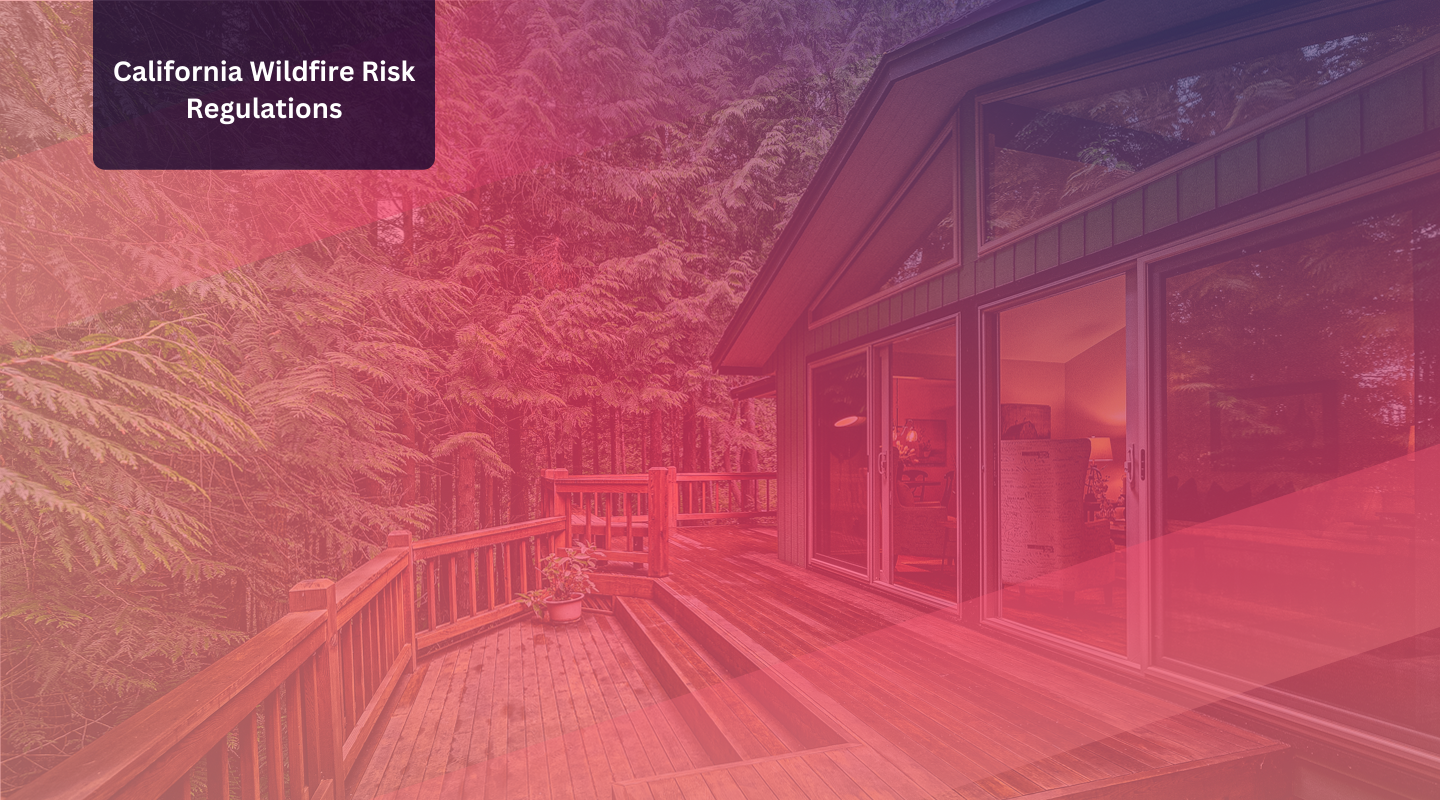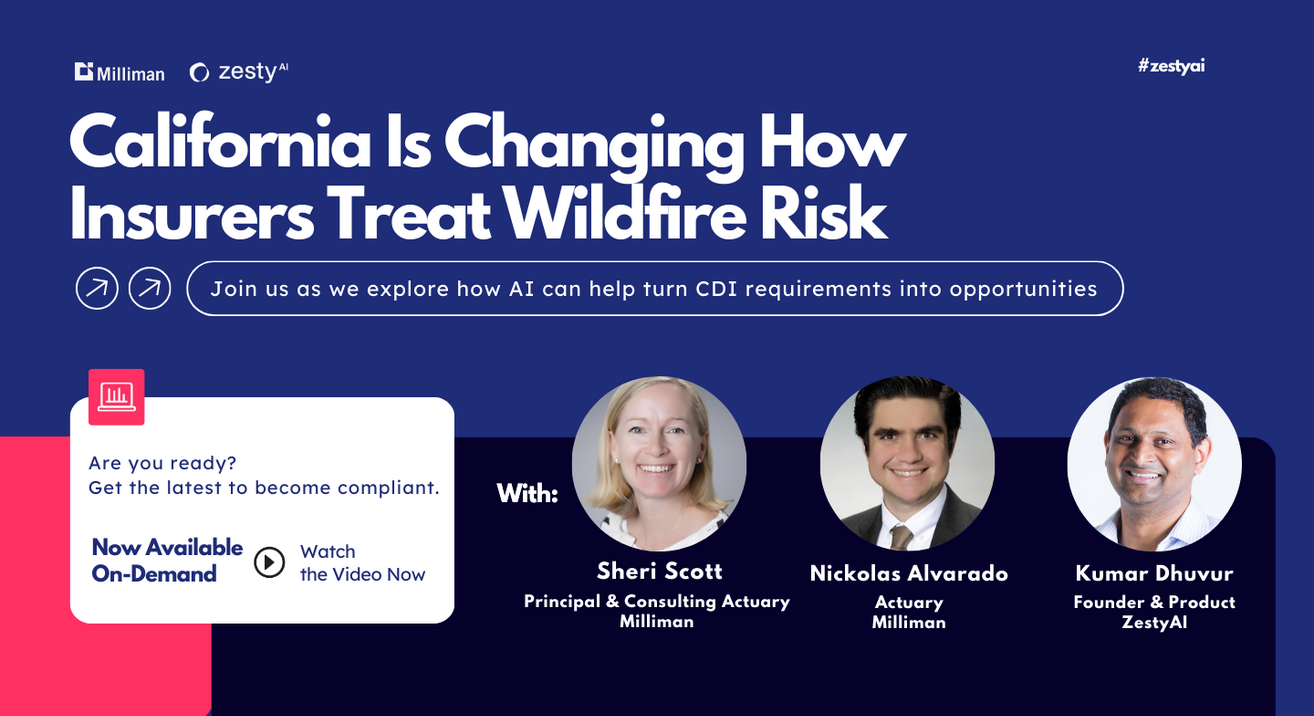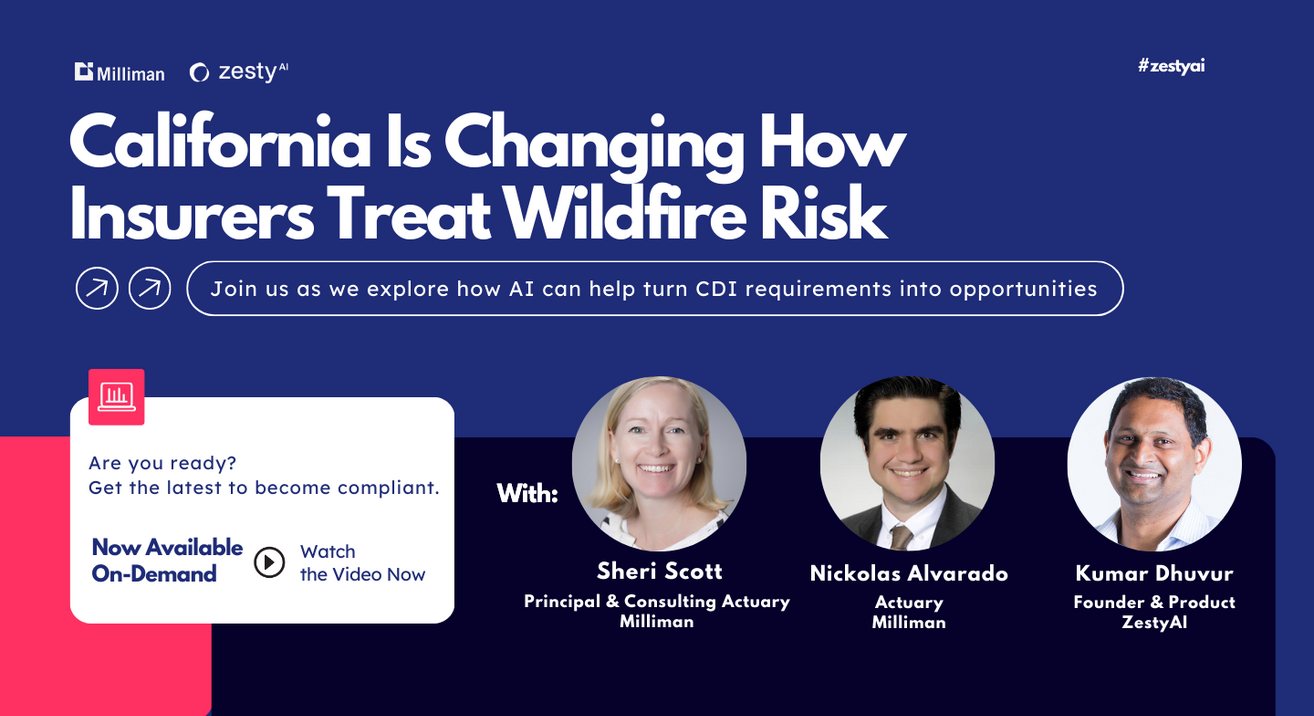California’s New Wildfire Risk Regulations: Your Top 10 Questions Answered
On October 14th, 2022, the California Department of Insurance (CDI) passed new regulations titled "Mitigation in Rating Plans and Wildfire Risk Models" to provide a more transparent approach to wildfire risk management in the state.


As a result, California insurers must submit a rate application that complies with these new regulations by April 12th, 2023.
To help insurers on their journey towards compliance, Milliman and ZestyAI teamed up on March 2nd to provide guidance and best practices to ~200 industry professionals, including top California insurers.
The event covered a range of topics, such as how leading insurers are meeting the new regulations, actuarial advice for applying for discounts, and how AI can help insurers turn these requirements into opportunities.
The panelists for the event included:
- Sheri Scott - Principal & Consulting Actuary at Milliman
- Nickolas Alvardo - Actuary at Milliman
- Kumar Khuvur - Founder & Product at ZestyAI
Available for a limited time - you can watch the webinar in its entirety

With the deadline for compliance fast approaching, it's essential for insurers to stay informed about these new regulations and take the necessary steps to ensure compliance.
These are the top 10 questions about California’s new wildfire risk regulation compliance, answered:
1. Which insurers are affected by this regulation?
The regulation applies to any insurer that factors in wildfire risk when calculating, developing, or charging rates. This means that if an insurer uses any rule or factor that differentiates rates based on wildfire risk, they must comply with the regulation. The regulation also includes rate plans that offer discounts or other rate differentials based on wildfire risk. For instance, if an insurer offers a brush discount, they are also subject to this regulation.
2. Which mitigation measures should you consider in your rate plan?
To comply with the CDI regulations related to mitigation in rating plans and wildfire risk models, insurers need to consider specific factors at both the community and property levels. These factors fall into three categories: community level designations, immediate surroundings, and building hardening.
Community level
Community level designations refer to measures that consider how the community as a whole is managing wildfire risk. These include the Firewise USA site and fire risk reduction communities. Insurers need to ensure that the city is enforcing building codes, that vegetation is properly managed, and that development areas have an adequate buffer zone to prevent structures from being built in risky areas.
Immediate surroundings
Immediate surroundings refer to measures that are specific to the property being evaluated. There are five property-level items that need to be considered, including clearing vegetation and debris from under decks, ensuring noncombustible materials within five feet of the building, and compliance with Section 429 of the public resources code. Additionally, maintaining a defensible space around the structure, removing trees close to chimneys, and maintaining vegetation around the house are important steps to mitigate risk.
Building hardening
Building hardening measures refer to specific steps that can be taken to make the structure itself more fire-resistant. There are five property-level building hardening measures that insurers need to consider, including a Class A fire-rated roof, enclosed eaves, and at least six inches of noncombustible vertical clearance at the bottom of the house.
While these measures are required to be considered in rate plans, the regulation notes that they are not the only factors that insurers should consider. It is important for insurers to evaluate additional factors that may impact wildfire risk and incorporate them into their rate plans as appropriate. By following these best practices, insurers can help mitigate wildfire risk and ensure that their rate plans comply with CDI regulations.
3. What are some filing best practices?
When submitting rate filings, there are several best practices you should consider to ensure that your changes don't erode your premium without a reduction in your expected loss ratio. Here are some tips to keep in mind:
Think through your new rate changes
If you're introducing new discounts, surcharges, or other factors, make sure to consider the impact on your premium over the long term. For example, if you introduce a wildfire scoring model that only includes discounts, you could erode your premium without realizing it.
Complete the CDI Questionnaire for Homeowners of Residential Property
The CDI requires the questionnaire to be completed for each homeowners rate filing when submitting a rate filing. Having the questionnaire ready and submitted with your initial filing can make your filing more efficiently reviewed. Additional requirement: Complete the Mitigation in Rating Plans and Wildfire Risk Models Questionnaire. This new filing must accompany each insurers’ rate filing.
Put together strong actuarial support
Use complete actuarial support for your wildfire rates, whether it's internally developed support or the ZestyAI team and Milliman's indication template.
Consider the Actuarial Standard of Practices (ASOPs)
Make sure to consider all of your ASOPs when submitting your filing, and keep in mind that when it comes to publicly filed support, California is not a "me too" state.
Support your model
If you're introducing a model into your rate plan, you'll need to support the model and its intended use. ZestyAI has a filing packet available, but you'll need to satisfy your actuarial standards of practice and the CDI model checklist.
By following these filing best practices, you can ensure that your rate filings are efficient and effective, and that they accurately reflect the risk exposure of your business.
4. Do the mitigation factors have to be in the form of credits, or can they be in the form of debits for the absence of a factor?
There are several ways to introduce these mitigation factors. One option is for a carrier to create a table that ensures revenue-neutrality, with surcharges and discounts combining to balance each other out. If carriers decide to introduce all factors as discounts, they should follow CDI's guidelines that advise carriers not to offset their base rate unless they are certain which properties qualify for discounts and which do not. It is important for carriers to introduce these factors in a actuarial sound manner.
5. How does ZestyAI assist carriers in complying with the regulations?
ZestyAI is prepared to help carriers attain regulatory compliance across three efforts:
Incorporation of property-Level and community-level mitigation in new rates
There are 12 mitigation factors required by the new regulations. ZestyAI is able to account for all factors, including the two community-based factors — Firewise USA site and Fire Risk Reduction Community (Board of Forestry).
Communication and transparency requirements for homeowners
The regulations require carriers to provide not only a written notice of the wildfire risk score, but also a range for how much the score could be improved, the reasoning behind the score, an explanation of possible mitigation measures, and an appeals process. Z-FIRE™, which was built with transparency in mind, provides the top risk drivers for each score as well as offering a tool to recompute risk scores in the appeals process.
Transparency in model usage and data credibility
ZestyAI has been very transparent with regulators about the Z-FIRE™ model. The model was thoroughly reviewed by the CDI and Taylor & Mulder. All of the necessary ASOP forms and validation reports needed for filing are included in the Z-FIRE™ filing packet.
6. How one could think about offering mitigation credit for property-specific mitigation factors?
ZestyAI provides both neighborhood and property-specific scores for community factors, along with reasons for the score's value. The company also offers access to data regarding whether the property is in a fire-prone area or part of a fire risk reduction community.
They launched a California Compliance Pre-Fill product in March of 2023 to capture all ten property-specific mitigation factors required for mitigation credits. This product aims to help insurance carrier partners fully comply with regulations, as it provides significant operational advantages.
ZestyAI launched the California Compliance Pre-Fill product in March of 2023 to capture all ten property-specific mitigation factors required for mitigation credits. This product aims to help insurance carrier partners fully comply with regulations, as it provides significant operational advantages.
Alternatively, carriers can pursue alternate data collection methods, such as asking homeowners about implemented factors and demanding evidence, or deploying a home inspection to verify compliance. While these methods present challenges, the CA Compliance Pre-Fill product aims to simplify the compliance process for carriers.
7. How can mitigation credits be applied?
There are multiple approaches for how to distribute this discount between the various factors, such as community factors or property level factors.
Linear approach
The first approach is a linear one where the discount is divided equally among all the mitigation factors.
Nonlinear approach
The second approach is a nonlinear one where different factors can receive different discounts based on a rational explanation. For example, a higher discount can be given for community factors and a lower one for property.
Hybrid approach
The last approach is a hybrid one that provides a discount for each mandatory factor and an extra discount for completing all of them. Giving a 0% discount for each mitigation factor and putting all the discount in the completion incentive is not consistent with the CDI's thinking.
ZestyAI has developed a framework to calculate the overall discount that can be offered for completing all of the mitigation credits. This discount only applies to the wildfire portion of the premium, not the entire premium.
8. How do you comply with the communication and transparency requirements?
In order to comply with communication and transparency requirements, insurance carriers must provide homeowners with a written notice of their risk score, along with a range of potential scores and their position within that range. The carrier must also provide reasons for the score and any possible mitigation measures. The ultimate goal is to help homeowners reduce their risk and understand how that translates to a reduction in premium. Additionally, policyholders have the right to appeal if they disagree with any part of their score.
The ultimate goal is to help homeowners reduce their risk and understand how that translates to a reduction in premium.
Z-FIRE provides all of this data, including both level one and level two scores, through an API and web application. If a policyholder appeals a score and presents evidence, the insurance carrier can easily request a change to the relevant information, such as the year of construction for a property. The updated score is then automatically generated and made available in the UI, along with an audit trail of any changes made. This functionality not only streamlines the appeals process, but also helps carriers in scenario planning.
9. Regarding the appeal process, is there a required form of appeal such as written, or can it also be verbal? Also, when submitting a filing, does it need to include a tracking component?
When it comes to the appeal process, there are a few questions that often come up. Firstly, is there a required form of appeal? Can it be verbal or does it need to be written? Secondly, should the filing and appeal process include a tracking component?
Have a clear and documented process in place
In terms of the required form of appeal, there is no set requirement. However, it is recommended to have a clear and documented process in place for consistency and accuracy. As for the tracking component, it is important to file all consumer notifications with the department, including applications and declaration pages. This helps to ensure compliance with regulations and avoid any issues during financial examinations or complaints from consumers.
Focus should be on compliance
It's also worth noting that while it's important to explain the appeal process, it's not necessary to create a detailed underwriting process manual to submit to the department. The focus should be on compliance with regulations, and any additional information should only be included if it adds value.
What works best for you
As for implementation, carriers have different operational processes, and it's important to find what works best for your organization. The CDI recognizes this and is open to different approaches.
The ultimate goal
The ultimate goal is to provide consumers with the right information so they can make informed decisions. To make this process as seamless as possible, the platform should facilitate tracking and provide helpful tools for consumer notification discussions. It's recommended to take screenshots and submit them for approval to ensure consistency in the information provided to consumers.
10. Some carriers may be under the assumption that a base rate offset would be allowed and, in fact, required for the filing to be revenue neutral. Is this the case?
Revenue-neutrality
Being revenue neutral means that the average rate level does not change if the average risk level stays the same. In California, the rate development process requires using a 20-year lookback period and actual wildfire experience data to develop rates. This experience data already includes mitigation measures, but it's uncertain which properties have them in place. Therefore, the average rate level already accounts for the average state mitigation.
Introducing discounts
If you introduce discounts without offsetting the base rate, you will erode the rate. To avoid changing the average premium, you need to increase the base rate. However, the department's position is that because you can't be certain which properties have mitigation measures in place, introducing discounts could have unintended consequences. They suggest introducing factors that are revenue neutral or waiting until you have all the data before offsetting the base rate to account for discounts that were introduced to satisfy the regulation.
Revenue-neutral factors & alternatives
The department doesn't want you to guess the impact and potentially raise rates unnecessarily. To achieve revenue neutrality from both an actuarial and department perspective, it would be best to introduce revenue-neutral factors. Pre-Fill is a great way to go about this. Alternatively, you could wait until you have all the data and follow up with a rate filing.
That being said, Pre-Fill is better than the alternatives. Pre-Fill offers rapid compliance with low operational burden. For instance, ZestyAI’s CA Compliance Pre-Fill product allows insurers to incorporate the 12 mandatory risk factors required by the regulations quickly and accurately, while also providing them with the data they need to file a base rate offset for discount-driven revenue losses.
Conclusion
In conclusion, California’s new Wildfire Risk regulations have significant implications for carriers who use wildfire risk in their calculation or development of rates.
Carriers are required to consider community-level designations and mitigation factors affecting a building’s immediate surroundings and its hardening measures. They must also provide policyholders with details about their score and associated premium reductions, as well as establish an appeals process.
ZestyAI is ready to help carriers comply with these regulations through their Z-FIRE™ product, which assists with incorporating property-level and community-level mitigation factors into new rates, assigning risk levels to properties, and preparing carriers for transparency in model usage and data credibility.
Overall, these regulations aim to mitigate wildfire risk and promote transparency and fairness in the insurance industry.
Contact ZestyAI today to discuss how you can attain regulatory compliance

Available for a limited time - you can watch the webinar in its entirety
The advice presented in this blog post should not be substituted for professional advice. We recommend you contact an actuary to discuss how your business can best comply with regulations, or ZestyAI about their Z-FIRE product. Please reach out to Sheri Scott at Milliman or Peter Schneider at ZestyAI for additional information.









